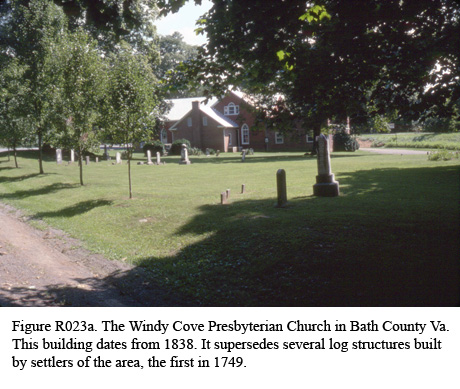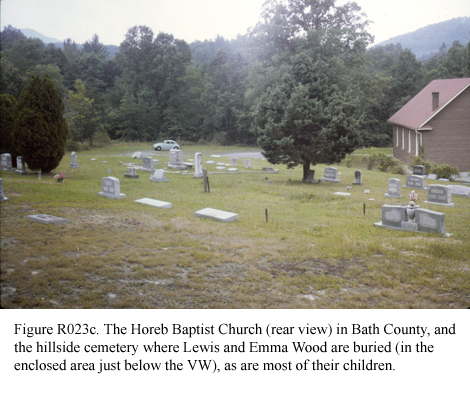R023
Bath County churches
The oldest Bath County church that figures in this history is the Windy Cove Presbyterian Church, near Millboro Springs. The early history of this Church testifies to the importance the first settlers attached to gathering for worship. It was founded about 1747; Presbyterianism was the faith of the dominantly Scotch-Irish settlers. The Church successively occupied four buildings. The first was a small structure of unhewn logs, with a large open fireplace and loopholes for rifles to defend against Indians. It was located on “Betsy Bell Hill,” about a mile south of the present Church, near Rte. 42. There is a granite marker commemorating the Church about 20 yards from the highway (which I have not seen). This building was burned by the Indians between 1753 and 1763, in a period when they began raiding the settlers in the area, which was then part of Augusta County. Kemp Wood [R550] wrote an account of the legend of the origin of the name of the hill where the church was located, which is reproduced in [R906].
The congregation built a second Church about 1766, several hundred yards west of the Church’s present site. This building too was of unhewn logs, with rifle loopholes for defence. A third Church was built of hewn (squared) logs on or near the site of the present Church at an unknown date. John Sitlington [R512] and Nathaniel Crawford [R506] are listed by the History of Windy Cove Presbyterian Church [S048] as being Elders of the Church “at the outset,” but since these ancestors did not come to the area until 1774 [S004] they did not join the congregation until the time of the second or third building. In 1833, during the time of the third Windy Cove Church building, the following were listed among communicants: Rebecca Bratton [R510], Martha Crawford Burger [R505], Samuel Crawford [R511], William Crawford [R510], Mary Feamster Sitlington [R521], Thomas Sitlington [R521], Mary Snyder Sitlington [R521], and Edward Woods (sic) [R003].
In 1838 the main part of the present Windy Cove Church was built out of bricks that were made and burned on the site. Additions were made to the Church in 1917 and 1959.
Our family is also concerned with the Indian Hill Church, about ten miles SW of the Windy Cove Church, which had a much shorter active life than the latter. On July 13 1844, Thomas Sitlington [R521] chaired a public meeting to discuss the establishment in that area of a Methodist Episcopal Church. A committee of five was appointed to superintend construction of the Church. This included Sitlington, Edward Wood [R003], and Shepherd Gilliland [R303], all of whom lived in the neighborhood of the proposed Church. The work was divided by elements of the building: Wood was responsible for one side wall and half the floor joists, Gilliland for the other side and more joists, Sitlington for one end of the structure, etc.
It is unclear what happened to this original Church, but a second Indian Hill Church was built on a different site donated by Stonewall [R358] and Lee Armentrout [R357]. It was built by Presbyterians, Baptists, and Methodists for the use of all, but deeded to the Presbyterian Church. The dedication was in 1895. In time the congregation turned out to be too small to support a minister; the Indian Hill Church was run as an “outpost” of the Windy Cove Church, which the Windy Cove minister visited once a month to conduct services. More recently the finances of the Windy Cove Church have not permitted the maintenance of outposts, and the Indian Hill Church was closed about 1970. The building, at the foot of the hill bearing the Indian Hill Cemetery, appears still to be in good condition.
Lewis E. Wood [R005] and his children were strongly oriented to the Baptist Church. Lewis was one of the founders of the Horeb Baptist Church (Fig. R023a.), which was organized in 1876 and constructed in 1887, conveniently near to the McDannald place where Lewis and Emma lived at that time (Fig. R005b). The first church was a white frame building facing the highway, with two front doors. Women and girls entered the left door and sat in pews on that side, males entered and sat on the right. The first pastor was John M. Pilcher, the minister who married Lewis and Emma Wood in 1877. In 1929 a tornado blew away everything except the floor and the church organ. The church was rebuilt in 1930 of brick, with only one front door. The organ that survived the storm is still in use today. Lewis and Emma Wood and most of their children are buried in the Church cemetery [R022].

